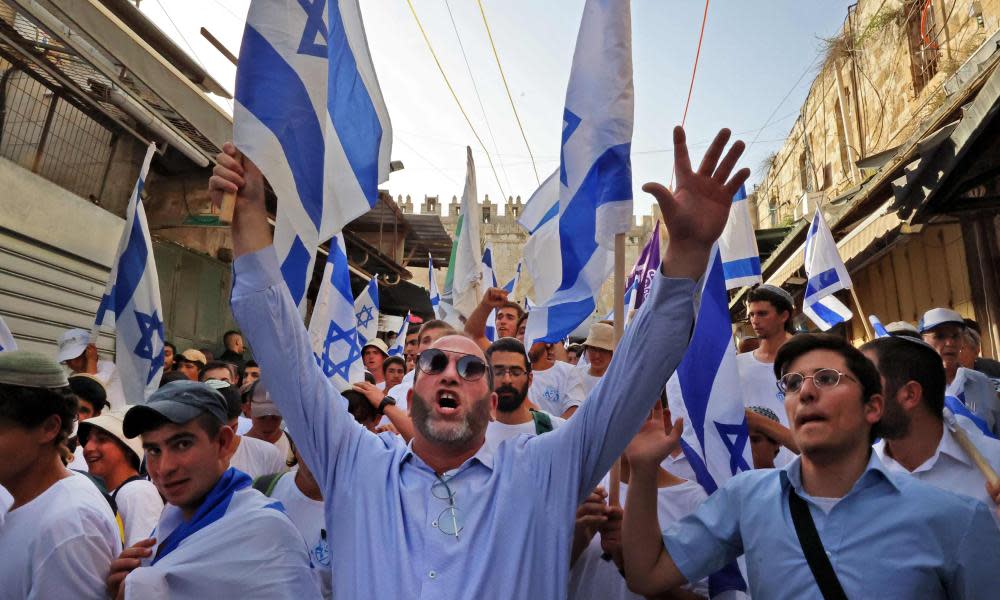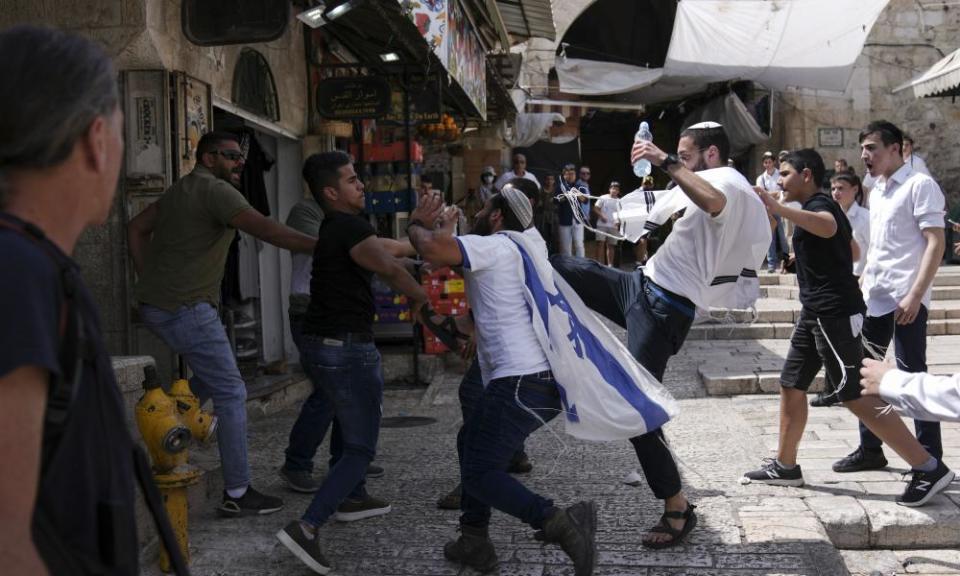Clashes in Jerusalem as Israeli nationalists march through Muslim Quarter

Thousands of Israeli religious nationalists have paraded through Muslim parts of the Old City of Jerusalem, putting the city on edge after violence during the same event last year helped spark an 11-day-war between Israel and Hamas, the Palestinian militant group in the Gaza Strip.
The annual flag march, in which religious nationalists enter the highly symbolic Damascus Gate and walk through the Muslim Quarter waving Israeli flags, takes place around sunset on what Israel calls Jerusalem Day, the celebration of the capture and annexation of East Jerusalem in the 1967 war, a move that is not internationally recognised.
Often accompanied by violence, the march through the bustling Muslim thoroughfare is seen as deeply provocative by the Palestinians. The decision to let it go ahead on Sunday despite a recent wave of violence across Israel and the occupied Palestinian territories drew criticism from both the West Bank’s Palestinian Authority and neighbouring Jordan, which remains the custodian of Jerusalem’s Muslim holy sites, who warned it could set off further violence.
Crowds, mostly made up of young Orthodox Jewish men, began gathering at the Damascus Gate around 3pm, chanting and dancing. As the afternoon wore on and their numbers grew, local Palestinians began retreating from public spaces and closing their businesses.
Several scuffles broke out as the marchers tried to make their way into the narrow streets of the Muslim Quarter: both sides threw glass bottles, and the fighting was broken up by Israeli police using teargas, rubber bullets and batons.
One ultra-Orthodox man spat at and attacked an elderly Muslim woman, and the crowd jeered as the Palestinian Red Crescent tried to evacuate an injured Palestinian through the mass of people. The rescue service said 15 people were injured by Israeli police, including four who needed hospitalisation.
As the afternoon call to prayer rang out, the crowd began chanting “death to the Arabs” while banging on the metal shutters of Palestinian shops and restaurants with sticks and flag poles. Israeli media estimated that 25,000 people were in attendance.
This year the flag march comes at a particularly tense time: in the last two months Israel has suffered its worst wave of terrorist attacks for years, which have killed 19 people, while retaliatory Israel Defence Forces (IDF) raids in occupied East Jerusalem and the West Bank have left about 35 Palestinians dead, including the Al Jazeera journalist Shireen Abu Aqleh.

Accompanying clashes between Israeli police and Palestinian protesters have injured hundreds of people at al-Aqsa mosque compound, which is holy to both Muslims and Jews, who call it the Temple Mount.
“Last year it was not like this, the [Israelis] were afraid to come,” said restaurant owner Nidal Hajjar, whom soldiers did not allow to walk through the Muslim Quarter. “People from the US, UK, can come and pass by but not me, even though I was born here,” the 65-year-old said. “It’s always a mess here, but today is worse.”
About 3,000 Israeli police were deployed throughout Jerusalem on Sunday, with snipers patrolling the turrets of the Damascus Gate. According to the Israeli daily, Yedioth Ahronoth, the IDF is on a heightened state of alert across the occupied Palestinian territories, and has adjusted its deployment of anti-missile batteries in anticipation of possible rocket fire from both Gaza and Lebanon.
“We are here every day, but today is especially important because it symbolises everything about living in Israel,” said Yael Mishan, 28, an Israeli settler living in occupied East Jerusalem, who was walking past the scuffles with her husband and three young children. “We are grateful to the army and the police for keeping us safe. If anyone is afraid of violence today it should be them, not us.”
Earlier on Sunday, about 2,600 Jewish pilgrims visited the Temple Mount accompanied by Israeli police, a much higher number than usual.
The visit prompted about 40 Palestinians, who had barricaded themselves inside the mosque overnight, to throw rocks and fireworks. Israel’s police said in a statement that they locked the building’s gates and made several arrests before the situation quietened around midday.
Informally, Jews are allowed to visit, but not pray at the site. In recent years, however, growing numbers of Jewish visitors, sometimes praying or with police escorts, have inflamed longstanding Palestinian fears that Israel plans to annex the area. Israel says it is committed to maintaining the status quo, and accuses Hamas of inciting the recent violence.
Last year, amid weeks of unrest in Jerusalem, the Israeli government changed the route of the flag march at the last minute to avoid the Muslim Quarter, but it was not enough to prevent clashes between Israeli police and Palestinians at the Temple Mount. The violence at the holy site led Hamas to fire a barrage of rockets at Jerusalem, sparking last May’s war.
Despite calls for cancellation or rerouting of the march this year from some of his own coalition allies, Israeli prime minister, Naftali Bennett, decided to allow the parade to proceed as planned, saying that “flying the flag of Israel in the capital of Israel is an obvious thing”.
A Hamas spokesperson praised what they called “the great heroism” shown by Palestinians at al-Aqsa on Sunday, but the group appears wary of reengaging Israel in another round of fighting as it struggles to rebuild after last year’s war and keep the besieged Gaza Strip’s devastated economy afloat.

 Yahoo News
Yahoo News 
